Newsletter - June 2013
Burlington Historian

June 2013

100 Year Old Photograph of Baseball’s Frank Roth Added to Society’s Computerized Photo Collection
A rare photograph (shown below) of former major league baseball player Frank Roth, who resided in Burlington for many years and whose name is known by many, was recently loaned to the Society for scanning by Peter and Lori Hintz so that a copy of the photograph could be added to our computerized collection.
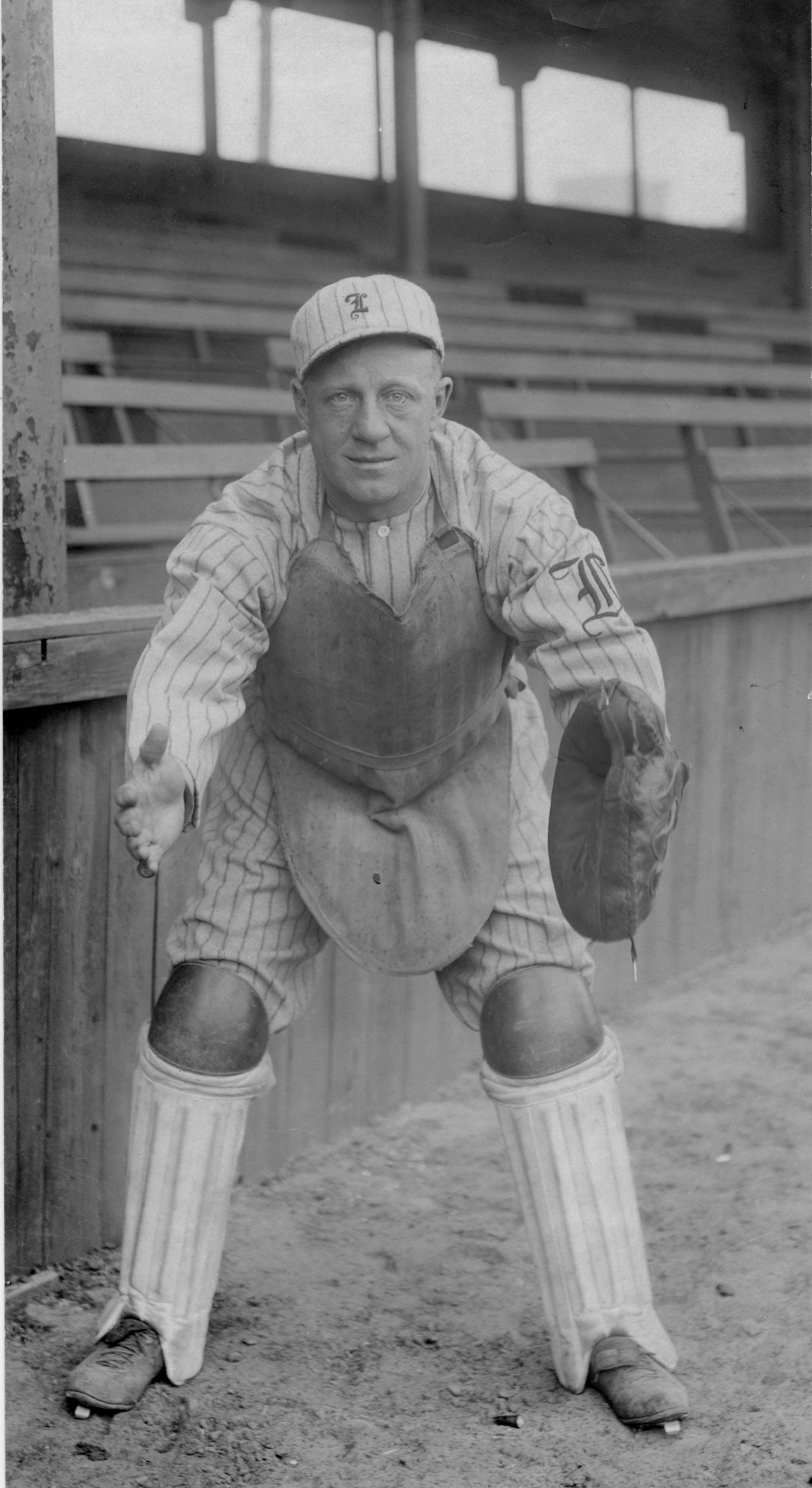 Roth’s name has been used for many years to denote one of Burlington’s two Little League divisions. The other division is named after Clarence "Ginger" Beaumont, another Burlington-area baseball great. So both names are familiar to not only those who have played Little League baseball in Burlington, but to their parents, grand-parents, and even, in some cases, their great-grandparents.
Roth’s name has been used for many years to denote one of Burlington’s two Little League divisions. The other division is named after Clarence "Ginger" Beaumont, another Burlington-area baseball great. So both names are familiar to not only those who have played Little League baseball in Burlington, but to their parents, grand-parents, and even, in some cases, their great-grandparents.
Francis Charles "Frank" Roth was born in Chicago in 1878 to Charles and Mary Roth. Mary was a native of Burlington and a sister of Frank Beller, long-time Burlington police chief. As a youth, Frank Roth spent summers in Burlington where, it is said, he played amateur baseball with and against "Ginger" Beaumont. Both entered organized baseball in the late 1890s, Beaumont with Milwaukee in 1898 and Roth with Manistee, Michigan, in 1899.
Roth went on to play minor league baseball with Sioux City, Iowa; Evansville, Indiana; and St. Joseph, Missouri, before entering the major leagues with the Philadelphia Phillies in 1903. He spent two years with Philadelphia before joining the St. Louis Browns in 1905. He was traded by the Browns to the Chicago White Sox organization in June of that year to complete a trade in which the Sox had earlier sent Branch Rickey to the Browns. He spent the rest of that season with Indianapolis of the American Association.
In 1906 Roth was acquired by the Milwaukee Brewers of the American Association as a platoon catcher, and he produced instantly, hitting .290 in 86 games. At that time, the American Association's season was shorter than the American League season, and after the Brewers closed out their 1906 schedule, Roth was "loaned" to the Chicago White Sox for the last 16 games of the big-league schedule. He helped the Sox win the pennant but, because he joined the club too late, he was ineligible to play in that year's Cubs-White Sox World Series which the Sox won.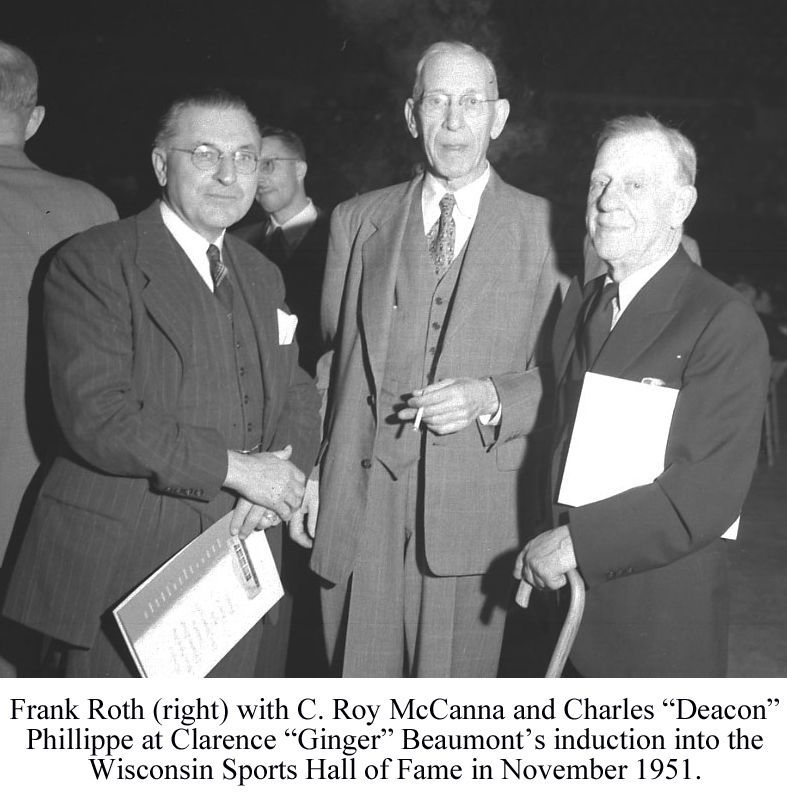
Roth was back at Milwaukee at the beginning of 1907 and remained there through 1908. He was then traded to the Cincinnati Reds of the National League, where he played for two seasons. From 1911 until retiring as an active player after the 1913 season, Roth played for the minor league teams in Montreal, Buffalo, and finally Louisville.
Following his playing career, Roth became a scout and then a coach. He coached with the Pittsburgh Pirates, New York Yankees, and Chicago White Sox. In 1921 he was the Yankees’ first coach assigned to handle pitchers exclusively. That same year, Frank's younger brother, Robert "Braggo" Roth was the Yankees’ second baseman. George Herman "Babe" Ruth was also a member of the team.
In 1914 in Chicago, Frank married Mary G. "Maude" Gleeson, a Burlington native. Maude provided the connection which resulted in the Hintz family having the Frank Roth photograph. Peter Hintz’s maternal grandmother, Lucy Gleeson Cunningham, was Maude’s younger sister.
After he retired, Roth did some umpiring, worked at the Burlington Brass Works during World War II to help in defense, and walked. He was a familiar sight walking down Chestnut Street, cane in hand, to the corner of Chestnut and Pine Streets (now Zumpano’s corner) where he would "perch" on the railing next to Pieters Mens Wear to share stories with anyone who happened to stop. He died in 1955 at age 76, about 2 years after Maude’s death. They are buried in St. Mary’s Cemetery, as are Frank’s mother and two of his brothers, Robert and Edward.
President’s Message
After what seemed to be a never-ending winter, it’s great to see the trees popping out and the flowers in bloom once again. Stop by the Museum and take a few minutes to walk through the adjacent Legacy Garden, maintained by the Burlington Area Garden Club, and see the beautiful and ever-changing collection of flowers and plants.
Our Society has had many positive comments on the "Remember Then" section of the monthly Discover the Treasures publication of the Burlington Chamber of Commerce. The photos are from the vast media archives of our Society, donated over the years by many individuals and families, and the captions are created from the superb research knowledge and efforts of our vice president Don Vande Sand. (In addition to the Chamber’s print edition, the articles are also available monthly on the Chamber’s website – http://www.burlingtonchamber.org )
Once again, we are asking our members and others to help us find a few volunteers to help out at the Museum for a few hours on Sunday afternoons. It would be great to have at least one more person available each Sunday to show visitors around the display rooms. Also, we would like to have some help with the Pioneer Log Cabin on Thursdays during the Farmer’s Market at Wehmhoff Square downtown. Spread the word around town and I’m sure we’ll find some volunteers who can share their time and knowledge with others.
We hope you have a great summer season and take advantage of the great places of interest and natural beauty spots that Wisconsin has to offer.
Dennis Tully
An Addition to the History of the Society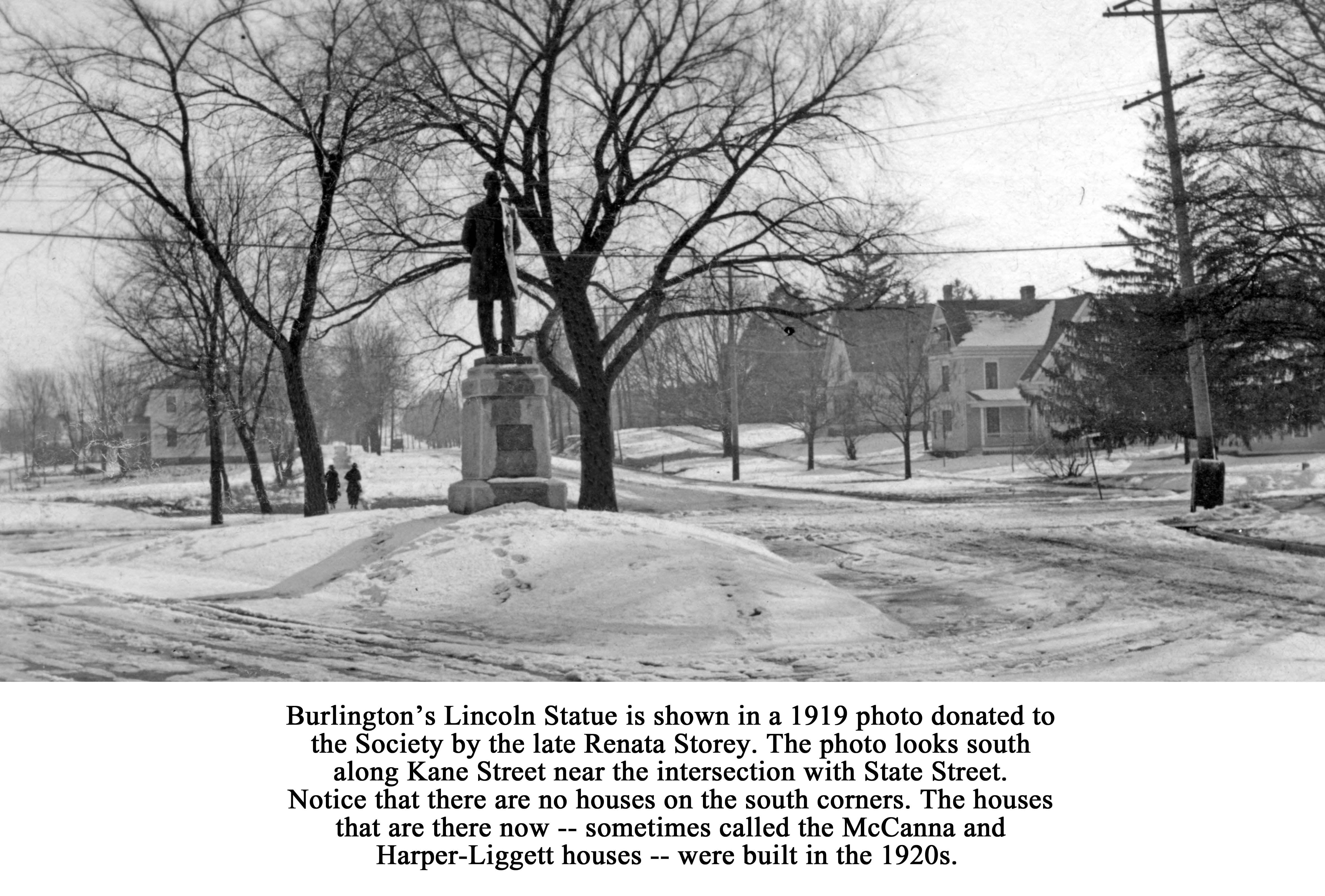
In our lead article in the March 2013 issue of the Burlington Historian, we outlined the many activities and projects that the Society had been involved in its 85-year history. One long-time member of the Society, however, noticed that we failed to mention one project that she vividly remembered.
In 1993-94 the Society spearheaded a community fund-raising effort to refurbish the one-of-a-kind statue of Abraham Lincoln that stands on Kane Street near the intersection with State Street. The statue depicts a standing Lincoln delivering his second inaugural address, which included the memorable words "With malice toward none, with charity for all . . ."
The statue, which had been donated to the City in 1913 by Dr. Francis W. Meinhardt, had become seriously dilapidated and in need of refurbishing. Under the leadership of the Society’s then-president Forrest Hoganson and his board members, including Doug Lind, Nick King, Susan Kaat, and others, the statue was professionally cleaned, a protective wax coating was added, and the statue was rededicated in ceremonies held in 1995.
Thanks to Arlene Hoganson for reminding us of this important event in the Society’s history. We apologize for not including it in our previous newsletter.
Burlington’s Second Water Tank
After 48 years of serving Burlington’s water needs, the wooden water tank atop the 1890 stone water tower on Lewis Street collapsed on July 19, 1938, sending about 40,000 gallons of water down nearby streets. Just over a month later, a new tank was in place and being used. The following article, taken from the Standard Democrat of August 26, 1938, links the two water tanks.
Wooden Pegs Have Part in Water Tank
Son of Builder of Original Tower Has Had Long Experience in Building
Forty-eight years ago when the wooden water tank was being built for Burlington’s new waterworks plant, a lad of 14 helped at the job, assisting his father, head of the Eagle Tank Co. that had the contract for the tank, and one of the most experienced tank builders of his day.
Part of the boy’s work was to make the wooden pegs that pegged the staves of the huge tank together to keep them in place. The pegs, about the size of a man’s little finger and about as long, were whittled and shaped by hand in those days.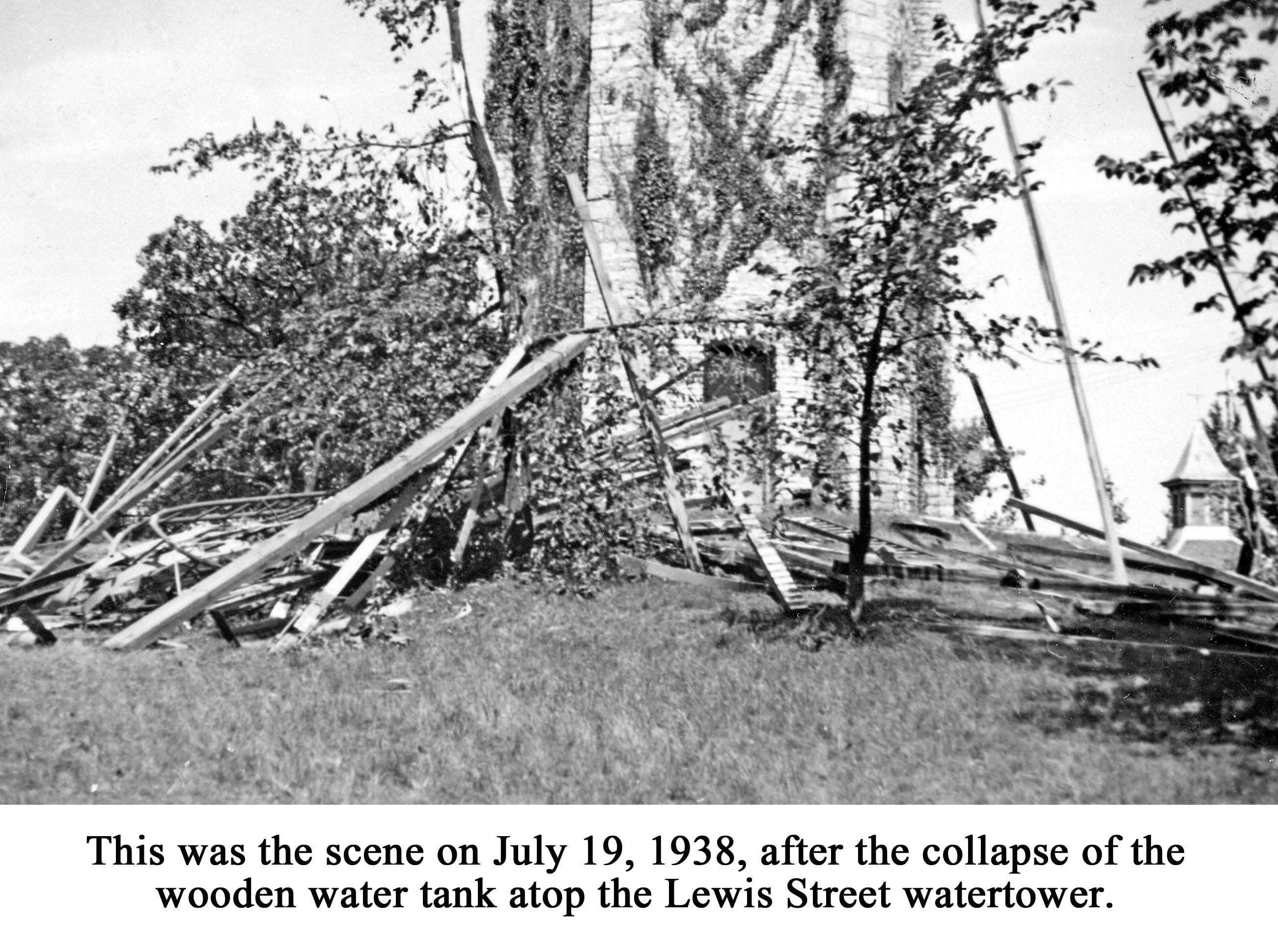
When the water tank collapsed on July 19, because the iron hoops were too weakened by exposure to stand the strain of tightening, the staves fell apart, revealing the pegs that the lad had formed with careful craftsmanship.
W. O. Olsen who today, as successor to his father, is president of the Eagle Tank Co. of Chicago, began his life’s trade in just this simple way.
When the city councilmen, looking for a contractor to rebuild the wooden water tank, studied the figures and specifications of Mr. Olsen’s company, they offered the Eagle Tank Co. the contract for the second time to build the water tank. The third generation is now connected with the business established by the senior Olsen. His son’s daughter is treasurer of the company and an active business woman.
Red Gulf cypress is the material used to build the new tank, the same kind of wood used in the first tank, a lumber that comes from the swamps of Louisiana.
Cypress, according to J. Niskala, foreman of the crew that built the watertank, is superior to other wood for tank purposes. It is durable and weather resistant, and is a wood that "breathes," a quality desirable for tanks for drinking water.
The new city water tank holds 50,000 gallons. It is built of 3-inch staves, 24 feet high and has an inside diameter of 19 feet 6 inches. Thirty round iron hoops bind the staves, an average of more than one to every foot of height, though the hoops are placed closer together near the bottom of the tank. The cost of the tank is $2,553. A wooden ladder has been built inside the tank and a steel ladder outside that reaches to the top. A special black paint that permits the wood to breathe has been used to coat the tank.
Workmen began hoisting lumber to the top of the tank on August 9 when the material arrived. The lumber had to be sent directly from the mills in Louisiana. Frank Weinman of the Burlington waterworks department used his motor car power to hoist the lumber.
Wooden pegs, the same kind that Mr. Olsen worked on when he was a boy, fasten the staves and help to keep the tank rigid as it is being built. The pegs today are turned on a machine lathe. The huge iron hoops come in three sections, Foreman Niskala explained, and are brought tightly together by means of patented lugs. Water was turned into the tank last Thursday and the city again received its water pressure from the elevated tank after just a month’s suspension of service.
- - - - -
The second water tank served Burlington’s water needs until 1955, when the Origen Street water tower and tank were completed.
An interesting aside is that the cypress wood from the tank that collapsed
was used by Edward Rueter in building the house at 416 S. Kane Street.
Contributed by Priscilla Crowley
Can anything beat the excitement of a school-age child who is fast approaching the last day of school before summer? It's like waiting for the first snowstorm of the season or waiting for the "big" snowstorm to hit – the one that's going to get you a freebie day off school. Once we get into May, the countdown begins and each day the excitement ramps up another notch until the last day when they can no longer contain themselves. The last day is the start of summer freedom, no clocks to watch, no homework to do, no teachers to worry about, nothing to do but enjoy as only kids can.
Children who normally follow most of the rules are starting to throw them out the window. Kids have their own set of logic – if school is almost out, that means I can’t get into that much trouble, how many detentions can I possibly get during the last couple days of school?
The three of us were no exception to the rule as the end of the year approached. A huge hurdle for us was the dreaded final exams that the nuns handed out each year. Of course, the nuns did not put these tests together. They were official tests that came in a sealed package from the Archdiocese. We were told that all test results would go on our permanent record; if we didn’t do well, the Bishop would know and so would every prospective employer we would ever have. The other consequence of blowing the test would be not moving on to the next grade. No one wanted to be left behind while all your classmates moved forward. This was a small school; it's not like you could fake anyone out – kids would definitely know if you didn’t move up the ladder with the rest of them. No pressure, just do your best; remember if you studied hard all year, you should have no problem. That statement is not completely accurate. We had a few problems. We studied very hard in math, reading, language, spelling, and geography. At least we all stood a fighting chance at those exams. But science was another matter. We were lucky if we opened up a science book more than twice throughout the year. They asked questions on that test about things we had never even heard of. What's a fulcrum and what do you do with it anyway? Are ice cubes liquids or solids? What’s a gas? I thought gas was something Dad put in the car – you mean it’s not? Why didn’t anyone ever tell me this? What in the world is H2O? And always lurking in the back of your mind is, "This goes on your permanent record; everyone will know if you don’t get a good grade." Needless to say, we were not shining stars in the science department and it all went on our permanent records!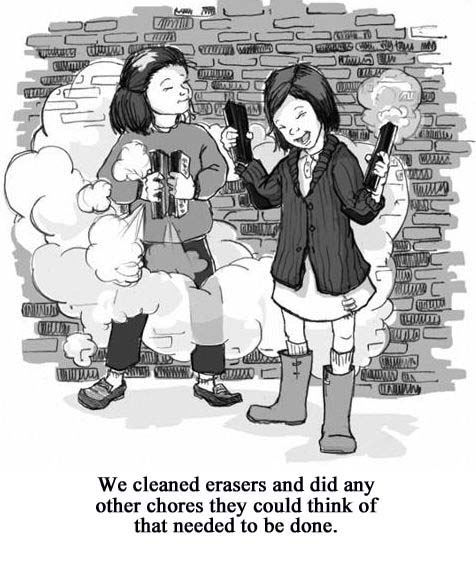
As the days slipped by one by one and as we got the exams out of the way, the mood began to lighten and the kids turned back into their usual optimistic selves. Hey, summer was nearly upon us; we had lived through the exams; how bad could it be? If a nun didn’t look at you sadly, shake her head, finger her rosary beads and "tsk, tsk, tsk" at you it had to be a good thing. One thing the nuns did know was what kids were good for. The last couple of days were cleaning days. They turned us older kids loose with paper towels, rags, window cleaner, dust rags, brooms, dust mops and anything else that would clean. We washed windows, scrubbed desks, dusted window sills, cleaned bookshelves, weeded flower beds, washed blackboards, cleaned erasers, and did any other chores they could think of. It was actually a lot of fun. We worked off some of that extra energy and they got a lot of chores done without having to lift a finger. Something for everyone!
Of course in and amongst the cleaning, there had to be a certain amount of horseplay. I'm sure it was an accident that one of the boys in my class went home from school completely drenched in water and that one of the girls wound up with chalk dust all over her dress and in her hair. Hey, these things happen! I mean it couldn’t have been anything other than an accident that one of the girls wound up with a lump on her forehead where a bucket accidentally hit her – I guess she should have ducked. The boy that went home with finger paint all over his shoes wasn’t a big hit either. There was a lot of tsk, tsking over these misadventures.
Through it all, anxiety over tests and wondering if everything really did get recorded on your permanent record for all the world to see, the stress of wondering if you were moving to the next grade, the excitement over the approaching last day of school, and looking forward with gleeful anticipation to summer vacation, the excitement continued to hover in the background.
The ending of the school year is like finishing a chapter in a book. The chapter is one more chapter in our book of life. All of the memories we have, whether they are from the end of one school year or the starting of a new school year, are all part of our own personal books. That book is something that we have with us for our whole lives. Memory by memory we build the story of our life, everything we have ever done or ever will do is a part of that book. So while our grades may not be of monumental importance to any of our past or future employers and really didn’t get recorded as part of our permanent record for everyone to see – our individual "Book of Life" is part of our permanent record and is to be treasured and valued for what we have become and what we have accomplished.
Be proud of those memories in your book, they have helped to make you the individual you are. Without you, the world would have had a void that no other person could ever fill. In the grand scheme of things, our individual life books make up a tapestry of life and living for our civilization. Each one of us has a purpose and place in this old world. Without us, it wouldn’t matter if the world keeps turning, we are what make it all work. Every once in a while take a look at your "Book of Life" and be proud of what you see. After all, it is all a part of our "permanent record."
